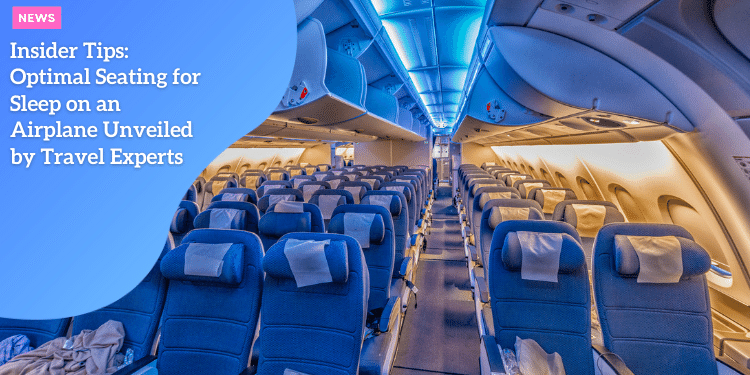Insider Tips: Optimal Seating for Sleep on an Airplane Unveiled by Travel Experts

Anúncios
Conquering the Skies: Unveiling Insider Tips for Optimal Sleep on Airplanes
For many, air travel presents a double-edged sword: the thrill of exploration juxtaposed with the struggle to achieve restful sleep amidst the constraints of a pressurized cabin. Fear not, weary voyager! By harnessing the wisdom gleaned from seasoned travelers and sleep experts, we can unlock the secrets to a rejuvenating journey. This guide delves into insider tips on optimal airplane seating, empowering you to transform your next flight into a tranquil oasis.
The Allure of the Window Seat: A Haven of Peace
Amongst the contenders for in-flight comfort, the window seat reigns supreme. As avid traveler Gabby Beckford proclaims, its appeal lies in its ability to cultivate a haven of peace. Shielded from the constant activity of fellow passengers, the window seat offers an uninterrupted environment conducive to sleep. Leaning against the supportive wall for extra comfort, passengers can gaze out at the breathtaking tapestry of cloudscapes, fostering a sense of serenity and relaxation.
Front-Row Freedom: Embracing Smooth Skies and Tranquility
For those prioritizing a smooth ride and uninterrupted slumber, front-row seating emerges as a strategic choice. Nestled closer to the plane’s center of gravity, these coveted spots experience less turbulence, creating a haven of stability for sleep. Renowned travel blogger Sean Lau champions the benefits of front-row placement, citing its ability to transform air travel into a tranquil experience. With minimal foot traffic and a more stable environment, front-row seating empowers travelers to truly embrace the serenity of the skies.
Steering Clear of Turbulence: The Aft Section’s Detriments to Sleep
While the allure of ample legroom in the rear rows may beckon, seasoned flyers advise against this section for optimal sleep. Notorious for turbulence and frequent interruptions due to lavatory traffic, the aft section presents formidable challenges to those seeking slumber. Sean Lau warns against the pitfalls of the tail-end journey, highlighting the bumpy ride and the constant hum of movement as significant deterrents to tranquility. By strategically avoiding the rear rows, travelers can significantly reduce potential disruptions and maximize their chances of a restful voyage.
Beyond First-Class: Optimizing Comfort for Budget Travelers
While first-class cabins undoubtedly offer unparalleled luxury and comfort, budget-conscious travelers need not despair. Strategic seating choices can still pave the path to a well-rested journey. For those prioritizing legroom, the exit row presents a haven despite its limited recline capabilities. By leveraging the insights shared by seasoned travelers like Gabby Beckford and Sean Lau, passengers can craft a comfortable sleep experience without exceeding their budget. Whether nestled in a coveted window seat or strategically positioned in the front row, these insider-approved secrets empower travelers of all budgets to transform their in-flight experience into a restful haven.
Beyond Seating: Additional Strategies for Sleep Success
Equipping yourself with the right tools and techniques can further enhance your in-flight slumber experience. Consider investing in a comfortable neck pillow to provide proper head and neck support during sleep. Noise-canceling headphones can effectively block out the ambient cabin noise, while an eye mask can shield you from unwanted light disruptions. Additionally, maintaining a regular sleep schedule, even while traveling, can help regulate your body’s natural sleep-wake cycle.
Pre-Flight Sleep Strategies: Setting the Stage for Success
On the night before your flight, prioritize a good night’s sleep to ensure you board the plane well-rested. Avoid consuming excessive caffeine or alcohol before your flight, as these substances can disrupt sleep patterns. Opt for hydrating beverages like water to combat dehydration, a common side effect of air travel that can worsen fatigue.
In-Flight Relaxation Techniques: Quieting Your Mind and Body
Once onboard, establish a relaxing pre-sleep routine. Gentle stretches or light meditation can help ease tension and prepare your body for sleep. Listening to calming music or reading a book can distract your mind from the hustle and bustle of the cabin environment. Dimming your overhead light can further signal to your body that it’s time to wind down.
Power Napping for Short Flights: A Strategic Approach
For shorter flights, power napping can be an effective strategy to combat jet lag and arrive at your destination feeling refreshed. Aim for a nap of 20-30 minutes to avoid entering deep sleep stages, which can leave you feeling groggy upon waking. Set an alarm to ensure you don’t oversleep and miss your connecting flight or arrival.
By following these valuable tips and insights from travel experts, you can transform your next flight into a rejuvenating experience. So, the next time you embark on your aerial odyssey, rest assured that with a little planning and strategic seating selection, you can conquer the skies and arrive at your destination feeling refreshed and ready to explore!






